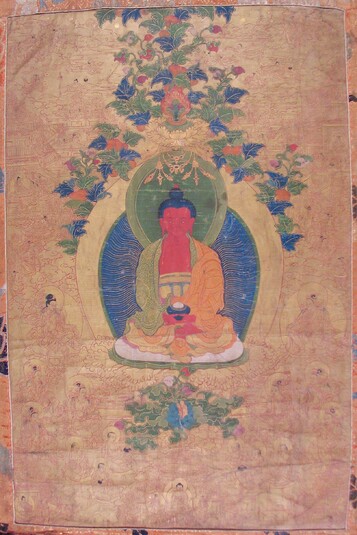
Item: Amitabha Buddha - Pureland (Sukhavati)
| Origin Location | Tibet |
|---|---|
| Date Range | 1700 - 1799 |
| Lineages | Gelug and Buddhist |
| Material | Ground Mineral Pigment on Cotton |
| Collection | Rubin Museum of Art |
Classification: Deity
Appearance: Buddha
Gender: Male
Amitabha Buddha (Tibetan: san gye o pa me. English: the Buddha of Boundless Light) in the pureland of Sukhavati teaching to the eight great bodhisattvas, shravakas and pratyekabuddhas.
Seated in the perfect posture of meditation, red in colour with one face and two hands, blue-black hair in tufts with a red top-knot ornament and the split ears of a prince, he wears the robes of a fully ordained monk. The two hands are placed in the lap in the mudra (gesture) of meditation and hold a black begging bowl. With the two legs folded in vajra posture seated above a lotus and peacock supported throne, he is surrounded by a dark blue and gold nimbus and green aureola under a canopy of flowers blossoming above, adorned with jewels.
Seated at the sides and below are the Eight Great Bodhisattvas, 'the heart sons of the Buddha,' each with their own colour: Avalokiteshvara, Maitreya, Kshitagarbha and Samantabhadra, Vajrapani, Manjushri, Akashagarbha and Sarvanivarana-vishkambhin.
Surrounding the central figure are numerous scenes depicting the heaven of Sukhavati filled with palaces, gods and flying monks.
Amitabha Buddha resides in the western direction in the pureland called Sukhavati (Tib.: dewa chen. Eng.: Land of Great Bliss). Full descriptions of his iconography and environment are found in the Sukhavati-vyuha Sutra.
This type of painting is called 'ser tang' - gold ground. The entire ground is painted with gold and the figures painted in outline with dark red or brown pigments. The central figure is highlighted with more or less colour depending on the wishes of the donor or the pleasure of the artist.
Jeff Watt 10-2007
Reverse of Painting
English Translation of Inscription: (See reverse of painting).
Special Features: (Printed script (Uchen), includes "Om Ah Hum" inscription)
Painting Type: Gold Ground
Buddhist Deity: Amitabha Buddha Main Page (阿弥陀佛 / འོད་དཔག་མེད།)
Collection of Rubin Museum of Art: Painting Gallery 4
Collection of RMA: Best of Collection 3
Buddhist Deity: Amitabha Buddha (Sukhavati, Square Format)


